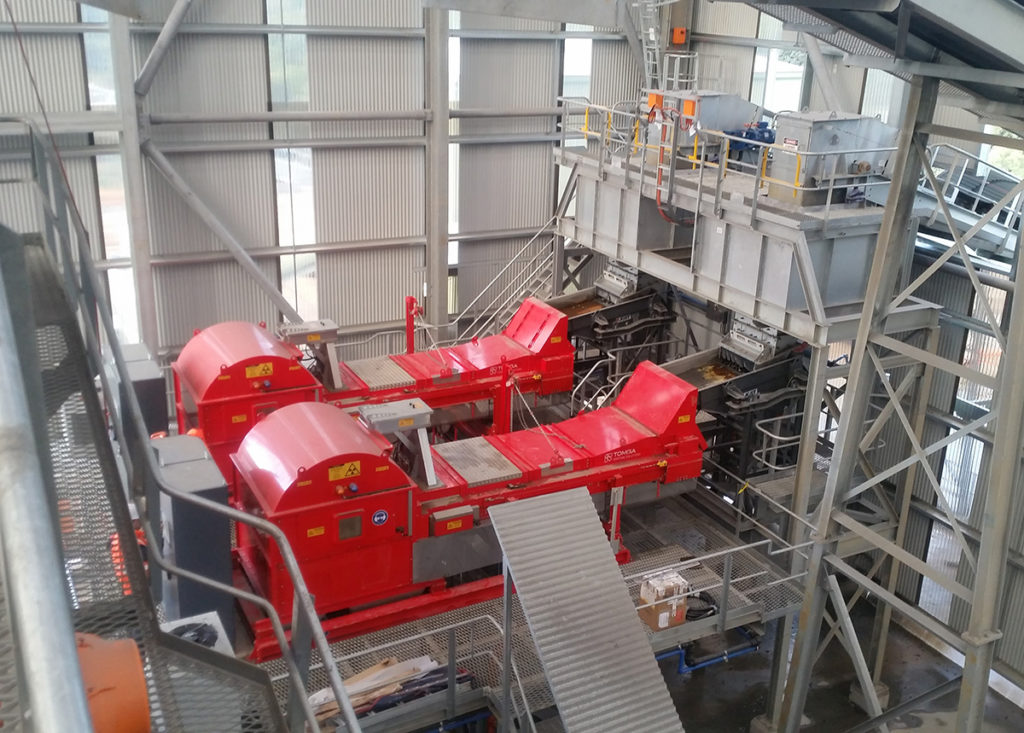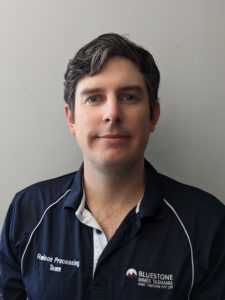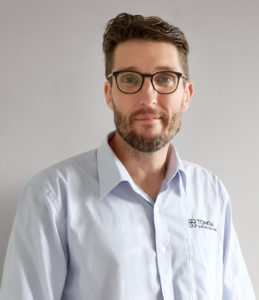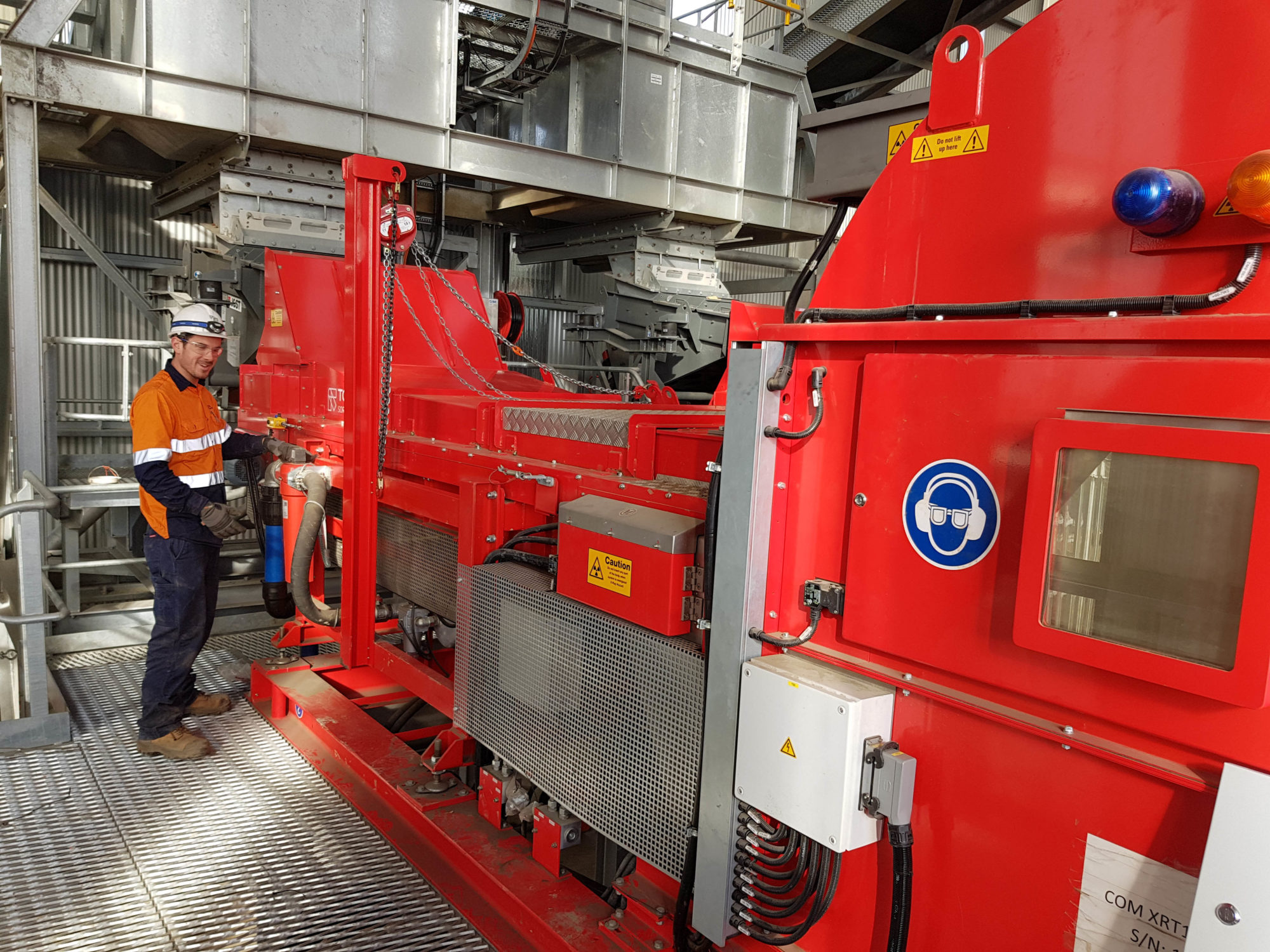TOMRA Mining and its X-ray Transmission (XRT) technology has, the company says, provided an effective solution for the extreme conditions at the Bluestone Mines Tasmania JV (BMTJV) Renison tin mine in Tasmania, Australia, with sensor-based ore sorting solution unlocking significant value and delivering environmental benefits.
The Renison mine is 50% owned by Metals X through the BMTJV, and is the only major tin mine in production in Australia with a mining rate of close to 1 Mt/y, according to TOMRA. While slated capacity is 1 Mt/y, the concentrator is restricted to 750,000 t/y.
The mine’s extreme humidity and highly acidic processing water (pH around 4.5) create unique challenges for the sorting process, the equipment and waste management, according to TOMRA.
A complex flowsheet
The underground mine operates a primary crushing system before the material is transported to the surface through a shaft. Once there, it enters the pre-concentration plant, where it undergoes a three-stage crushing, screening and cleaning process. The particles are split into two fractions – 10-25 mm and 25-60 mm – which are fed into two TOMRA XRT sorters. The output consists of two streams: the product, which is transferred to the wet plant, and the waste, which is fed into a TOMRA EM sorter to separate acid-forming sulphides from this waste stream.

In the wet plant, the product goes through primary grinding followed by bulk sulphide flotation. The tailings are processed downstream to concentrate the cassiterite tin mineral through gravity concentration; gravity tails are further treated via desliming and tin flotation. The combined concentrates are fed to a leaching circuit to remove carbonate minerals. After a final wash stage, the concentrate is de-watered and dispatched.
BMTJV approached TOMRA to address two key requirements at the plant. The first was the need to upgrade the tin feed to the plant, as Ben Wraith, Principal Project Metallurgist at BMTJV (pictured below), explained: “The Renison tin operation wanted to achieve economies of scale, putting more tonnes through the front end of the plant without upgrading the back end downstream – we wanted to do more with less.”

The second requirement was to address the environmental issue of removing acid-forming sulphides from the waste.
Following site visits and extensive discussions with BMTJV’s teams, TOMRA proposed a solution that addressed the tin feed quality with two COM Tertiary XRT 1200 sorters and the waste issue with a COM Tertiary EM 1200 sorter. A team from BMTJV visited the TOMRA Test Center in Sydney, Australia, where they observed what the XRT sorter operating at capacity is capable of.
Gavin Rech, Technical Manager at TOMRA, said: “Our XRT stands out for the high spatial and density resolution and its ability to do contrast sorting, identifying fine high-density tin inclusions in the ore with an accuracy that has no equal on the market. On top of that, it can separate it from the acid-forming sulphides, so that we have the ability of pulling the tin into the first product and sending the rest to the EM sorter.”

The two COM Tertiary XRT 1200 sorters went into operation in 2018. Initially, BMTJV’s strategy focused on low reject grades, devoting less focus to achieving the mass reject rate and overall process plant throughput. However, the specific conditions at the Renison mine affected the results achieved. The large variance in run of mine (ROM) particle size distribution resulted in insufficient stability in the feed to the circuit. In addition, the extremely wet conditions in west Tasmania and consequent high ambient moisture content, combined with the high moisture of the ore delivered from underground, further affected the sorting process.
In 2019, a new investigation was conducted into the ore sorting performance and led to a change of direction, where the operation shifted away from targeting low reject grades, towards sorting as aggressively as possible, according to Wraith, moving from a “tin recovery-based” operating strategy to a “mass reduction” one.
“We are getting 20-25% mass reduction, so 75-80% of the materials are going into the wet plant, and we are still achieving 97-98% tin recovery overall across the crushing circuit,” he said. “Pre-concentration didn’t materially impact overall recovery because the tin in the material that is rejected as waste is extremely fine grained and a proportion is associated with sulphides, so it wouldn’t have been fully recovered in the downstream wet plant and would have been lost to tailings.”
This approach, he said, is best for Bluestone’s application as it provides the ability to process 15-20% more tin units without having to upgrade the downstream concentrator.
Wraith added: “Operating the sorting circuit has slightly increased our overall processing cost, but this is more than offset by the large increase in ROM throughput by 15-20% and, thus, tin production, so the unit cost per tonne of tin produced is reduced by almost 10%. We’ve broken multiple production records in the last year in tin units, and this gives us confidence in what we can achieve because the machine performs over and over again if you treat it right and if you prepare your feed correctly.”
TOMRA XRT success leads to upgrade decision
In view of the results achieved with the two TOMRA XRT sorters, BMTJV decided to upgrade the ore sorting circuit with two new, recently launched XRT models with stainless steel internal parts and advanced features such as the TOMRA ACT user interface and the TOMRA Insight cloud-based platform, according to TOMRA.
“The decision to buy new machines was easy,” Wraith said. “The stainless steel will assist prolonging the TOMRA sorter’s life by protecting the unit from our high-moisture and corrosive environment. The more ergonomic design will help our maintenance teams, which is particularly important for machinery operating in these harsh conditions.”
Wraith said the use of TOMRA Insight, the ore sorting company’s subscription-based service that relays and analyses machine data, will “enhance everybody’s understanding and experience of the machines”.
He added: “It will be more of an analytical platform for our metallurgy and maintenance staff, providing ample opportunity to gain valuable information that can be analysed and optimised over time. The one feature I am personally interested in is the particle size monitoring through the machines, which will enhance our overall circuit performance because we have an integrated circuit with the crushing and screening plant. Feed preparation is key to maintain a consistent performance – knowing how well you’re preparing your feed in a live fashion can only end up with a better result.”
TOMRA will also be able to log into the machine and check the daily reports generated by TOMRA Insight, so its technical teams will be prepared ahead of site visits for maintenance or optimisation.
Wraith concluded: “TOMRA has been working with the site maintenance team to tailor solutions to our operating environment, which has been invaluable. TOMRA supported me through site visits, which included equipment inspections, site-based training of our personnel, and an openness to continually improving the technology and finetune it to our site-specific requirements. They assisted the site with troubleshooting, optimisation, discussing the nuts and bolts of the issues as they arose, and finding a solution that works.”











